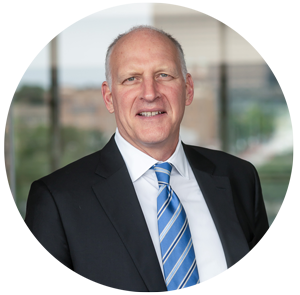The Bottom Line - Banking on Clarity

Banking On Clarity
Uncommon understanding: why it matters now more than ever
A one-size-fits-all approach to banking has never worked for us here. Forms, templates, and standardization have their place, but the finer points and nuances of a business and its past, present, and future, that matter most, tend to come out in quieter and more candid moments.
Conversations have been a hallmark of our approach since we began. In-depth personal visits and discussions, which encompass everything from facility tours to lunchroom meetings to boardroom reviews, have always been our preferred method of communication.
That’s because we’ve learned over the years that mutual success—ours and yours—starts with mutual understanding.
Not the surface-level kind that typically appears in a sales call. We’re talking about the type of understanding that comes from taking the time to truly know someone, their business, their goals, and their story. We call it uncommon understanding, and it’s how we’ve done business for generations.
That kind of understanding only happens when you invest in listening and learning. And learning comes from asking better questions, letting people talk, and, perhaps most importantly, staying at the table —not just when times are easy, but also when situations get challenging.
Because that’s when trust is built, and when you have trust, you can move more quickly, make better decisions, and create outcomes that benefit everyone involved.
It’s not just a philosophy. It’s how we’ve earned a seat at the table with Kansas City businesses for years. And it’s why we’ve been able to help our clients navigate everything from growth opportunities to generational transitions with confidence and clarity.
As we anticipate moving forward with our merger with FNBO, the concept of uncommon understanding takes on even greater significance. Because our respective organizations share so many of the same principles and values, our plans have been guided by the same humility, curiosity, and collaboration that we practice with clients.
We’ve gotten to know each other, our businesses, and our markets. This combined acumen and attentiveness are good for all of us in Kansas City.
It tells you that the values we hold dear, such as relationships, trust, integrity, and shared success, will not only remain intact but will also continue to guide us as we grow together.
This integration won’t always follow a straight line. But the key to navigating it successfully lies in our people, our values, and the depth of the relationships we’ve built. That continuity matters. It means the people you trust are still here, still listening, and still committed to doing the right thing.
That’s what uncommon understanding looks like, and it’s why we’ll continue to be more than just your bank. We’ll be your advisor, your advocate, and someone you can count on to bring perspective, expertise, and ingenuity.
Thank you for your continued trust in Country Club Bank. It’s our privilege and honor to serve you, and we look forward to continuing to serve you with even greater understanding and clarity in the years to come.

— Joe Close, President, Country Club Bank, Member FDIC
Economic Insights
Slower spending and economic expansion balanced by new market highs
Concerns about economic slowdowns due to tariffs have eased as consumer confidence and spending have rebounded in recent weeks. Inflation has edged higher modestly, job growth remains steady but subdued, and new tariffs are building pressure on prices and business planning.
Consumer prices rose 2.7% year‑over‑year in June, up from 2.4% in May. Core inflation also ticked upward, as goods such as durable items saw steeper price increases. Overall Personal Consumption Expenditures inflation forecasts in 2025 range from 2.3% to 2.7% year-over-year.
While some indicators show a slight easing in May 2025, the Federal Reserve remains concerned about somewhat elevated inflation. Factors like tariffs and potential trade wars are also influencing predictions.
In its June meeting, the Federal Reserve held the federal funds rate steady at 4.25–4.50%, signaling a cautious wait-and-see approach, with notable questions surrounding trade policy and consumer behavior. The median Fed expectation remains for two modest rate cuts later this year, although some policymakers foresee none or just one cut, depending on the risks to growth and inflation.
In June, the U.S. economy added 147,000 jobs, while the unemployment rate decreased to 4.1%, continuing to show stable levels and demand. Job growth was concentrated in the government and healthcare sectors, while manufacturing saw declines. Private sector hiring slowed, with the weakest showing since October 2024.
The Federal Reserve and other forecasters now expect GDP growth of around 1.4% in 2025, down from earlier estimates near 1.7%. Some Fed governors are concerned that first-half growth is tracking closer to 1%, and rate cuts may be delayed as inflation remains stubbornly high. The New York Fed anticipates unemployment rising to around 4.5% by year-end and inflation remaining near 3–3.5% before easing in 2026–2027.
Tariff policy continues to cloud the picture. Starting this year, the U.S. has raised its average applied tariff rate, including sweeping 25% duties on steel, aluminum, and autos, as well as a 10% baseline universal import tariff on nearly all goods, a historic high level.
Bottom Line: The economic environment still requires a cautious approach to cost management, pricing flexibility, and ensuring access to credit. Additional planning and scenario testing of trade policy shifts, inflation surges, and tighter credit conditions should also be part of cash flow planning, particularly in businesses where supply chains are vulnerable to sudden price increases.
Looking ahead, high confidence levels in ongoing stability will require a calibrated monetary policy, more clarity on trade outlooks, and disciplined fiscal execution in Washington. Until then, resilience will come from adhering to fundamentals such as managing costs, maintaining access to capital, and focusing on core strengths.

— Marcus Scott, CFA, CFP®, Chief Investment Officer (CIO) for Country Club Trust Company
CFA® and Chartered Financial Analyst® are registered trademarks owned by CFA Institute.
Certified Financial Planner Board of Standards Inc. (CFP Board) owns the certification marks CFP®, CERTIFIED FINANCIAL PLANNER®, CFP® (with plaque design), and CFP® (with flame design) in the U.S., which it authorizes use of by individuals who successfully complete CFP Board's initial and ongoing certification requirements.
The opinions and views expressed herein are those of the author and do not necessarily reflect those of Country Club Trust Company, a division of Country Club Bank, or any affiliate thereof. Information provided is for illustrative and discussion purposes only; should not be considered a recommendation; and is subject to change. Some information provided above may be obtained from outside sources believed to be reliable, but no representation is made as to its accuracy or completeness. Please note that investments involve risk, and that past performance does not guarantee future results.
Investment products are not insured by FDIC/other federal agencies; are not deposits of/nor guaranteed by CCB or any of its subsidiaries/affiliates; and may lose value.
Partnership Profile
Mies Family Foods Finds the Right Recipe for Growth with Country Club Bank
From door-to-door milk delivery to a $130 million protein distribution business, the story of Mies Family Foods is one of humble beginnings and extraordinary growth.
 What started as a one-person lunch meat delivery route has evolved into a major supplier serving restaurants, grocers, carnicerías, and food distributors across the Midwest. At every step, the company has stayed true to its core values: move fast, buy smart, and treat people right. That philosophy has also shaped its 20-year banking relationship with Country Club Bank.
What started as a one-person lunch meat delivery route has evolved into a major supplier serving restaurants, grocers, carnicerías, and food distributors across the Midwest. At every step, the company has stayed true to its core values: move fast, buy smart, and treat people right. That philosophy has also shaped its 20-year banking relationship with Country Club Bank.
“We’ve built an incredible team,” said Paul Mies, president and co-owner. “Our buyers make good decisions. Our operations team ensures that everything is delivered correctly. And our banking partners at Country Club Bank are there when we need them.”
Mies Family Foods was founded in the late 1960s by Ralph Mies, who had previously worked as a door-to-door milkman. He grew the company, put six kids through college, and one through medical school, and eventually sold the business to his sons in the early 1990s.
Today, the company is led by Ralph’s son, Paul Mies, who has been with the business for 35 years, and Ryan Hamm, who joined in 2014 after a career at National Beef.
“I used to sell Paul beef back when I was at National Beef,” said Hamm. “We built a great relationship over the years. Eventually, I called him and said, ‘I’m ready to make a change.’ Didn’t take long, and it’s just worked out.”
That kind of relationship-first approach extends to customers and suppliers, as well as to their bank.
“We’ve been with Country Club Bank for over 20 years,” said Hamm. “What sets them apart is how they work. They’ll bend over backwards to make sure things happen.”
That level of responsiveness has made a real difference over the years, especially during pivotal moments. When Mies and Hamm needed to buy out one of the founding partners, Country Club Bank facilitated the deal and closed it before year-end.
“We closed on New Year’s Eve,” said Hamm. “The deal had dragged out, but Country Club Bank stayed late, transferred the money, and made sure it happened. They went above and beyond.”
As the company expanded, it began to outgrow its North Kansas City facility, which it had acquired in 2012 following another acquisition.
By 2024, they were stepping over themselves in a 23,000-square-foot space. So Mies made another decisive call.
“One afternoon I turned around and said, ‘Let’s build a building,’” Mies said. “Ryan said, ‘I don’t hate that idea.’ We called a realtor that day and started the process.”
With financing from Country Club Bank, they broke ground on a new 79,000-square-foot facility in Kansas City, Kansas, and moved in just before July 2025. The new space features a 41,000-square-foot freezer, an 8,000-square-foot cooler, a 12,000-square-foot cold storage area, and ample room for future expansion.
“We don’t borrow a lot, but when we do, we need a bank that knows who we are and how we work,” said Hamm. “Country Club Bank has always been that for us.”
Dan Teahan, regional president at Country Club Bank, has been working with Mies Family Foods for over two decades.
“They’re the kind of business we love to support—hardworking, smart operators, and deeply respected in their space,” said Teahan. “It’s been incredible to watch them grow.”
Today, Country Club Bank provides Mies Meats with a full-service banking relationship, including operating accounts, treasury services, and credit facilities. Although Mies Meats is financially strong and keeps debt to a minimum, they value having the right partner in place when needs arise.
“They answer your questions quickly. It’s their day-to-day blocking and tackling that’s made us never look elsewhere,” said Hamm. “It’s not just about loans or accounts, it’s about people who answer the phone, who know our business, and who help us move quickly when something needs to happen.”
Succession Planning Insights
Handling the emotions of letting go and exiting with grace
For many business owners, the most challenging part of succession planning isn’t the legal paperwork or the financial forecasting. It’s the emotional letting go.
Whether you built your business from scratch or carried forward a family legacy, stepping away can feel like losing part of your identity. Who are you without your title? What happens when the decisions no longer run through you? These questions aren’t just logistical; they’re deeply personal.
Start with self-awareness
 Owning a business often involves making sacrifices, working late nights, making family tradeoffs, and taking years of risk. Giving it up may stir pride, grief, and even fear. That’s normal. The key is acknowledging those emotions rather than ignoring or suppressing them.
Owning a business often involves making sacrifices, working late nights, making family tradeoffs, and taking years of risk. Giving it up may stir pride, grief, and even fear. That’s normal. The key is acknowledging those emotions rather than ignoring or suppressing them.
You’re not just transitioning an enterprise, you’re entering a new phase of life. That shift deserves time and space.
Make a plan—and a timeline
A graceful exit doesn’t happen overnight. Ideally, succession planning starts 3 to 5 years before an owner steps down. This gives you time to identify successors, prepare your operations and finances, and communicate the transition clearly when you’re ready.
Whether you’re passing the reins to a family member, selling to employees, or bringing in outside leadership, transparency is critical. Your team will take their cues from you. If you model confidence, trust, and optimism, they’re more likely to follow suit.
Redefine your role (and your worth)
Many owners struggle with the question: “What will I do when I’m no longer in charge?” But stepping back doesn’t mean you lose your value. Some of your most significant contributions may come after the exit.
Consider how you might stay involved in a strategic or mentoring capacity, if appropriate. Or look ahead to what energizes you—volunteering, investing, consulting, or simply spending time with family. You must find a way to be at peace with your legacy without clinging to control.
Focus on the legacy, not the spotlight
One of the most powerful mindsets you can adopt during a transition is this: It’s not about me, it’s about what I’ve built with others. Letting go becomes easier when you see succession not as a loss, but as a continuation.
Your business’s next chapter is part of your legacy. And the way you exit, calmly, clearly, and without drama, can reinforce the culture and values you’ve worked so hard to create.
In the end, grace is the goal—and a gift
The most graceful exits are the ones that leave relationships intact, successors prepared, and the business poised for future success. That requires humility, courage, and care —qualities you’ve likely developed and practiced for years as a leader.
Letting go is hard. But doing it well is authentic leadership.
Personal Finance Solutions
Take Control of Your Money: How a Personal Finance App from Country Club Bank Helps You See the Big Picture
Managing your finances doesn’t have to be complicated, especially when the right tools are just a click away. With Country Club Bank’s Personal Finance feature, customers can now take a more complete, stress-free approach to managing their money.
Whether you're juggling accounts at multiple institutions or just want a better view of where your money is going each month, Personal Finance puts everything in one place.
Think of it as your financial dashboard: account balances, transactions, budgets, and even debt tracking, all accessible from your online banking login or the CCB mobile app.
Why Use It?
Seeing the whole picture helps you make smarter decisions. With Personal Finance, you can:
Once enrolled, the tool automatically connects your Country Club Bank accounts. From there, it’s easy to add outside accounts securely using your login credentials for each institution, or enter them manually if you don’t have online access.
Getting Started is Simple
First-time users will need to log in via Country Club Bank’s online banking site, click “Additional Services,” and select “Personal Finance.” You’ll be prompted to start linking your accounts. Once set up, your data is refreshed nightly, so your information is always current.
Security You Can Trust
All login information is encrypted and stored with the highest levels of security. You stay in control—your data is protected, and only you can access it.
Why It Matters
Better financial visibility means better decisions. Whether you’re planning for a big purchase, trying to reduce debt, or just keeping tabs on monthly expenses, Personal Finance gives you the tools to stay ahead of the curve.
Take the guesswork out of managing your money and start budgeting with confidence. Get started with Personal Finance Management today.